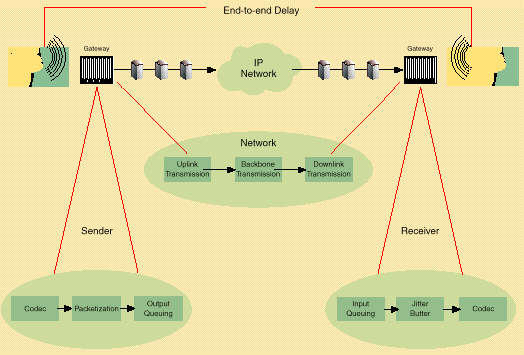Key VoIP Tests
Contents:
- Delay
- Jitter
- Packet loss
- Sequence Errors
- Recommendations for Measuring Voice Quality
- Objective Voice Quality Measurements
Delay
Excessive end-to-end delay makes conversation inconveient and unnatural. Each component in the transmission path - sender, network, and receiver - adds delay. ITU-TG.114 (One-Way Transmission Time) recommends 150 mSec as the maximum desired one-way latency to achieve high-quality voice.
Sample Delay Budget Table
| Parameter | Fixed delay | Variable delay |
| CODEC (G.729) | 25 mSec | |
| Packetization | Included in CODEC | |
| Queuing delay | Depends on uplink. In the order of a few mSec. | |
| Network delay | 50 mSec | Depends on network load. |
| Jitter buffer | 50 MSec | |
| Total | 125 mSec |
End-to-end Delay

Jitter
Quantifies the effects of network delays on packet arrivals at the receiver. Packets transmitted at equal intervals from the left gateway arrive at the right gatway at irregular intervals. Excessive jitter makes speech choppy and difficult to understand. Jitter is calculated based on the inter-arrival time of successive packets. For high-quality voice, the average inter-arrival time at the receiver should be nearly equal to the inter-packet gaps at the transmitter and the standard deviation should be low. Jitter buffers (packet buffers that hold incoming packets for a specified amount of time) are used to counteract the effects of network fluctuations and create a smooth packet flow at the receiving end.

Packet loss
Typically occurs either in bursts or periodically due to a consistantly congested network. Periodic loss in excess of 5-10% of all voice packets transmitted can degrade voice quality significantly. Occassional bursts of packet loss can also make conversation difficult.

Sequence Errors
Congestion in packet switched networks can cause packets to take different routes to reach the same destination. Packets may arrive out of order resulting in garbled speech.

Recommendations for Measuring Voice Quality
ITU-T Recommendations P.800 - Subjective quality test based on Mean Opinion Scores (MOS). Preselected voice samples recorded according to recommendation P.50 are played back to a mixed group of men and women under controlled conditions. The scores given by the group are weighed to give a single MOS score ranging from 1 (worst) to 5 (best). A MOS of 4 is considered "toll-quality" voice.
Mean Opinion Scores (MOS) for Various Voice Quality Tests
| Score | Opinion Scale: Conversation Test | Difficulty Scale | Opinion Scale: Listening Test | Listening: Effort Scale | Loudness: Preference Scales |
| 5 | Excellent | ---- | Excellent | Complete relaxation possible, no effort required | Much louder than preferred |
| 4 | Good | ---- | Good | Attention necessary; no appreciable effort required | Louder than preferred |
| 3 | Fair | ---- | Fair | Moderate effort required | Preferred |
| 2 | Poor | ---- | Poor | Considerable effort required | Quieter than preferred |
| 1 | Bad | yes | Bad | No meaning understood with any reasible effort | Much quieter than preferred |
| 0 | ---- | no | ---- | ---- | ---- |
Objective Voice Quality Measurements
- ITU-T Recommendation P.861 - Objective quality Measurement of Telephone Band (300-3400 Hz) Speech Codecs
- PAMs - Perceptual Analysis Measurement System (proposal from British Telecom)
- Intrusive methods based on comparison of a predefined speech sample before and after transmission through a codec or network.
- The resulting score approximates MOS scores as would be given by humans under recommendation P.800.